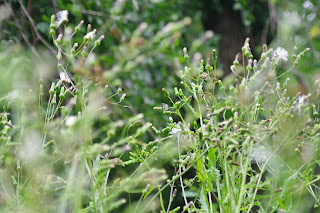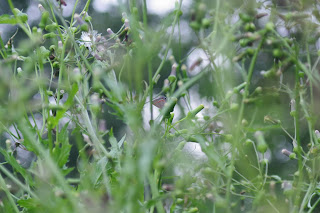My first camera was a gift from my parents when I "graduated" from elementary school. It was a 110 camera, and I was excited to have a camera of my own. It was very easy to use, just pop the film in, close the camera, and you're ready to take pictures. There was nothing electronic, or even electric. It was "focus free," which means it didn't really focus on anything in particular, but was just sort of in focus in general. The film was advanced by turning a wheel. There was one button, the shutter. It really only worked well in bright sunlight. It could take flash cubes, but they were expensive and I think flashed four times before needing to be replaced. I think I used the one that came with the camera and thenceforth never took another picture in low light with that camera. Basically, it was good for taking vacation snapshots, and pictures of your friends. I don't remember how I went about getting more film, or getting my pictures developed. I didn't take a LOT of pictures, because of needing film and developing. Also, I didn't have a lot to take pictures of. I do remember, though, that that was the beginning of my desire to take pictures of bugs. I never did, because there was a specific bug I wanted to take a picture of, and, well, that camera was not meant for such things. There were these tiny, blue butterflies that I would see once in a while, and I desperately wanted to take a picture of one, because I found them enchanting. Their tiny size and pretty color were wonderful to me, and there several occasions when I tried to take pictures of them with my 110 camera. I didn't see them very often, however, living in a suburban neighborhood where every house was surrounded by the ecological wasteland that is the American lawn. But aside from rarely seeing these butterflies, I had not chance at getting a picture of one because 1) my 110 camera wasn't really capable of such a shot, and 2) it's very difficult to get close to one of those butterflies. I will add, by the way, that I don't know what species they were, and if I was even seeing the same species all the time; now, decades later, I know that there are several possible species I could have been seeing. But I knew virtually nothing about insects back then. Anyway, I have had many cameras since then, moving up in quality and capability, and with each new camera I tried to take pictures of those tiny, blue butterflies. Most of my ensuing cameras were also not up to the task, and it was still very difficult to get close to them. And for a LOT of those cameras, missed shots or bad shots meant wasted film. But eventually I not only moved into digital cameras, which don't require film, and allow me to take as many pictures as I want, but a macro lens, which is great for taking pictures of insects. IF you can get close to them. And that has remained the problem with all of these tiny butterfly species. Yes, at times I have done it. I have taken decent, close-up pictures of many species of tiny butterflies, some of them even tiny blue ones that could be the same ones I have been trying to photograph since I was 11 years old. But oh, how difficult it is.
I suppose you probably think that this is all leading up to me showing you the amazing photo I took today of a tiny, blue butterfly, but it's not. Because I didn't get any good pictures of tiny, blue butterflies today. I got these:
I don't think this is even blue; I didn't get close enough to see. However, when we walked by this stand of plants at the beginning of our walk there were four of five tiny butterflies here, and they looked blue while they were flying. This might have blue on the dorsal side of its wings. It's a long story, but I didn't have my camera on the start of the walk, but when I came back, there were still butterflies here.
I don't know what this plant is; I thought it was wild lettuce, but now I don't think so. The interesting thing is that it is very attractive to these tiny butterflies, as I have seen them here for the last several days, but the flowers are not in bloom. Some of them have gone to seed, and some of them have seed heads that have not opened yet. They seem to be very attracted to the ones that are not open yet. I wouldn't think that they would have nectar, but maybe they do? I should mention that this is a pretty big patch of these plants, which are taller than I am, and of course the butterflies only landed on the plants that were nowhere near where I was standing.
Bonus points if you can see the wasp in this picture as well as the butterfly.
A bug walk did not seem to be in the realm of possibility for today because we were supposed to have a hurricane. Hurricane Henri appeared to be making a beeline for us. We worked very hard yesterday at battening down the hatches and preparing for violent weather and power outages. But Henri had powered down a bit by the time in came ashore, and after a bit of rain and some strong winds in the morning it just petered out by mid-afternoon. Once it became clear that we weren't just in the calm eye of the storm, when the rain ended, the winds died down, and the sun peeked through, we decided to go for a walk in the woods. I didn't bring my camera, in case it started to rain, and because it was incredibly humid, which means I would just sweat all over it, so naturally I saw a lot of bugs (including the aforementioned butterflies. And a LOT of frogs). Ah, well, I was resigned to missing out on all of those photo ops, but when we were almost back to the house I saw a caterpillar, one that I have not seen yet this year (and speaking of which, I have hardly seen ANY caterpillars this year. I know I haven't been doing regular bug walks, but I feel like I should still be seeing them when I am out there), so I went and got my camera. The caterpillar was on the move, but I figured I would be able to find it when I got there with the camera... and I was wrong. I couldn't find it anywhere. But since I was out there, and had the camera, I did walk around a bit, and went back to the patch above to see if there were butterflies (yes, as you can see, but not as many). And then, when I got back to my backyard I walked by the milkweed patch, not expecting to find anything but always hopeful and weirdly optimistic, and I found the Backyard Bug of the Day:
Monarch caterpillar! Yes, I know, I have already had a monarch caterpillar as BBotD, but that was a newly hatched, first instar caterpillar, and this one is a late instar (probably not the last, but close). This is the first one I have seen this year that has made it past its first couple of days after hatching, and a LOT of the eggs I saw never hatched at all. Also, this is my blog, I can break my own rules if I want, and I am so happy to have found this caterpillar that it is Backyard Bug of the Day. I am still not holding my breath that it will be able to mature into a butterfly, but it is the most successful monarch caterpillar in my backyard so far this year. Well done, little caterpillar!
Yeesh. I have written so much in this post... time for just pictures... Other Bugs:
Dragonfly
Oh, speaking of knowing nothing about bugs when I was a kid... I am re-reading a book that I read many times when I was a kid, Henry Reed's Journey, by Keith Robertson. The main character in the book, Henry Reed, is a smart kid, and he plans to be a naturalist when he grows up, and reads a lot about animals and nature. Anyway, the part of the book I just read while waiting for the dragonfly picture above to load said this: "I like bugs if they don't bite or sting, and the hundreds of different kinds are just as interesting as birds and a lot easier to catch." Yes, the "hundreds of different kinds." Hundreds. No wonder I had no idea when I was younger that there were SO MANY kinds of insects. Not only did I live in an ecological wasteland, and therefore extremely limited in the number of species I actually saw, but I was reading books in which characters who claimed to know a lot about nature said there were hundreds of kinds of bugs. So I had no idea there were over 20,000 species of bees. Or 925,000 identified species of insects. Or potentially 1.5 MILLION species of beetles. Children's literature misinformed me. (And a couple of pages later it said, "She argued that if a worm or a grub in a cocoon can change overnight into a butterfly..." No. Just no).
Anyway, I also had no idea that there was more than one species of cricket. I had no idea this existed:
Bush cricket of some kind.
Long-legged fly
I don't know what bees do during a hurricane; I assume the ones that have a hive go there, but there are solitary bees that I don't think have that kind of shelter. At any rate, when I saw bees out pollinating during our walk I took that as a sign that the storm was truly over.
I do know that in some inclement weather bumblebees just hang onto plants and ride it out. But in a severe storm? I don't know if they would do that.
I know this is a terrible picture (it was still pretty breezy when I was out with my camera), but I am sharing it because I think it's funny that I didn't notice the very obvious second bug when I took it. I can't tell if it's on the back of the bee or on the plant beyond it. Also, I like the little droplet of rain on the bee's back. A tiny remnant of the hurricane.
The only spider I saw today was the spined micrathena that has had a web across the path in the woods for the last week or so. I didn't have my camera, so I don't have a picture, but I did see her today. I was curious whether her web would be there today, and it was not, but she was sheltering under a leaf on one of the trees she has been anchoring her web to. I don't know if the storm wrecked her web, or if she took it down (ate it) because of the storm, and then just rode out the hurricane under the leaf. I am curious to see if she has a new web tomorrow.












No comments:
Post a Comment